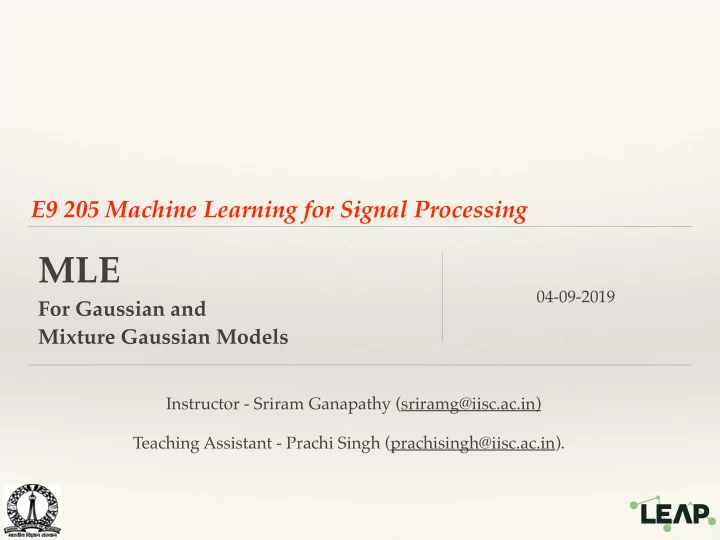

E9 205 Machine Learning for Signal Processing MLE 04-09-2019 For Gaussian and Mixture Gaussian Models Instructor - Sriram Ganapathy (sriramg@iisc.ac.in) Teaching Assistant - Prachi Singh (prachisingh@iisc.ac.in).
Finding the parameters of the Model • The Gaussian model has the following parameters • Total number of parameters to be learned for D dimensional data is • Given N data points how do we estimate the parameters of model. • Several criteria can be used • The most popular method is the maximum likelihood estimation (MLE).
MLE Define the likelihood function as The maximum likelihood estimator (MLE) is The MLE satisfies nice properties like - Consistency (covergence to true value) - Efficiency (has the least Mean squared error).
MLE For the Gaussian distribution To estimate the parameters
MLE Using matrix differentiation rules, for a symmetric matrix Using matrix differentiation rules for log determinant and trace ∂ tr ( AB ) = B + B T − diag ( B ) ∂ A Sample mean and Sample Covariance
Gaussian Distribution Often the data lies in clusters (2-D example) Fitting a single Gaussian model may be too broad.
Gaussian Distribution Need mixture models Can fit any arbitrary distribution.
Gaussian Distribution 1-D example
Gaussian Distribution Summary • The Gaussian model - parametric distributions • Simple and useful properties. • Can model unimodal (single peak distributions) • MLE gives intuitive results • Issues with Gaussian model • Multi-modal data • Not useful for complex data distributions • Need for mixture models
Basics of Information Theory • Entropy of distribution • KL divergence • Jensen’s inequality • Expectation Maximization Algorithm for MLE
Gaussian Mixture Models A Gaussian Mixture Model (GMM) is defined as The weighting coefficients have the property
Gaussian Mixture Models • Properties of GMM • Can model multi-modal data. • Identify data clusters. • Can model arbitrarily complex data distributions The set of parameters for the model are The number of parameters is
MLE for GMM • The log-likelihood function over the entire data in this case will have a logarithm of a summation • Solving for the optimal parameters using MLE for GMM is not straight forward. • Resort to the Expectation Maximization (EM) algorithm
Basics of Information Theory • Entropy of distribution • KL divergence • Jensen’s inequality • Expectation Maximization Algorithm for MLE
Recommend
More recommend